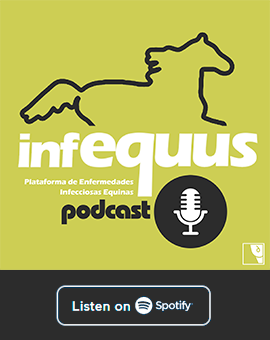African Horse Sickness
Etiology
It is a serious arthropod-borne viral disease of equids. African horse sickness (AHS) results from infection with the AHS virus, a member of the genus Orbivirus in the family Reoviridae. There are nine serotypes; serotype 9 is widespread in the endemic region, while serotypes 1 to 8 occur in limited areas. Serotype 9 has been detected in most of the outbreaks occurring outside Africa. There was an outbreak in Spain and Portugal in 1987-1990, caused by serotype 4, imported zebra from Namibia was the source of infection.
Epidemiology
It is endemic in sub-Saharan Africa; however, there have been outbreaks in the Midle East, the Mediterranean region of Europe and The Magreb.
Mortality rate is 50-95% in horses, around 50% in mules and around 10% in donkeys. Infections in zebras are subclinical, and they are believed to be reservoir hosts. Viraemia may be present in zebras for up to 40 days. Dogs can be affected after eating infected horsemeat. Antibodies have been found in African elephants and rhinoceroses too.
AHF is transmitted by Culicoides spp. C. imicola appears to be the principal vector; the disease has a seasonal incidence based on favorable climatic conditions for the breeding of insect vectors.
Establishing strict quarantine zones and movement controls is very important to prevent outbreaks outside endemic regions.
Pathogeny
There are four different forms of AHS. The incubation period is approximately between 3 and 5 days in the pulmonary-peracute form, between 7 and 14 days in the cardiac-subacute edematous form, between 5 and 7 days in the mixed form, and between 5 and 14 days in the fever form.
After infection, initial multiplication of AHSV occurs in the regional lymph nodes and is followed by a primary viremia, with subsequent dissemination to endothelial cells of target organs (lungs, heart and spleen). Edematous changes of various tissues, as well as serosal and visceral haemorrages are produced.
The viremia last in adult horses around 4-8 days. Donkeys and zebra have a lower viremia period than horses, but can last up to four weeks.
The factors determining the course and severity of infection are not well understood.
Clinical signs
Mixed form and pulmonary form of the disease predominate in horse populations. Fever is the mildest form and usually occurs in horses with partial immunity, mules and donkeys, although there may also be cases in zebras although they are mostly asymptomatic.
- Pulmonary form: It starts with an acute fever and a sudden onset of serious respiratory problems. Dilatation of the nostrils is characteristic. Other clinic signs may include tachypnea, forced expiration, sweating, spasmodic cough and frothy nasal exudate. It usually progresses rapidly and the animal usually dies a few hours after the onset of symptoms.
- Cardiac form: It begins with a fever that lasts from 3 to 6 days. Then appear edematous inflammations in the supraorbital fossa and the eyelids, which spread to the cheeks, lips, tongue, intermandibular space and laryngeal region. No edema is observed in the lower part of the limbs. Death occurs due to heart failure. If the animal recovers, the inflammations disappear during the next 3-8 days.
- Mixed form: Symptoms of pulmonary and cardiac symptoms are observed. In most cases the cardiac form is subclinical and is followed by a severe respiratory compromise. Death occurs due to heart failure. Rarely diagnosed during the clinic, it is observed in the necropsy of horses and mules.
- Fever form: Clinical signs are mild. The characteristic fever lasts from 3 to 8 days. Other mild symptoms may include anorexia or mild depression, edema in supraorbital pits, congestion of mucous membranes, and increased heart rate. Animals almost always recover.
- Equine Infectious Diseases, Debra C. Sellon, DVM, PhD, DACVIM and Maureen T. Long, DVM, PhD, DACVIM. SAUNDERS ELSEVIER.
- The Center for Food Security and Public Health
- MAPAMA
Diagnosis
AHS should be suspected in animals with typical symptoms of cardiac, pulmonary or mixed forms, supraorbital swellings are pathognomonic of this disease. Fever form can be difficult to diagnose. The differential diagnosis includes equine viral arteritis, equine infectious anemia, Hendra virus infection, purpura hemorrhage and equine piroplasmosis. When possible, more than one test should be used to diagnose an outbreak. Virus isolation (culture), RNA detection (PCR) or antigen (ELISA). Diagnosis can also be done by serology. The antibodies can be detected between 8 to 14 days after infection and these can persist from one to 4 years. AHSV does not cross-react with other known orbiviruses.
Treatment
There is no specific treatment for the AHS. Affected animals should receive supportive therapy, care and rest, as any effort can lead to death. Animals that survive must have 4 weeks of rest after recovery. There should also be carefully monitored for co-infections which can complicate recovery.
Prevention and control
Immunization is used in endemic areas. It is also convenient to stabling animals before sunset, since the vector has nocturnal activity and does not usually enter buildings. After a suspected outbreak in a country free of the disease, the following control measures must be instituted immediately; delimiting the area, restricting movements in and outside the area, stabling the animals at least from dusk to dawn, implementing vector control measures, monitoring the temperature of the animals to perform an early detection of the infected ones, and also the option of vaccinating the susceptible animals will be considered.
It is convenient to carry out entomological studies by placing traps to know the species of mosquitoes that can transmit the disease and when they appear in the region under study.
Public Health Considerations
It is not zoonotic disease, but It is a OIE notifiable disease.

